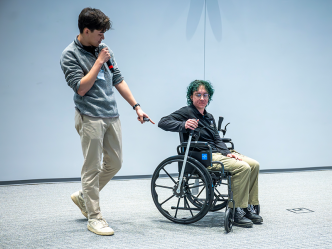In one type of a rare, inherited genetic disorder that affects control of body movement, scientists have found a mutation in an enzyme impairs communication between neurons and what should be the inherent ability to pick up our pace when we need to run, instead of walk, across the street.
The disorder is spinocerebellar ataxia, or SCA, a neurodegenerative condition resulting from different genetic mutations whose debilitating bottom line can include ataxia — loss of control of body movement — and atrophy of the cerebellum, a small part of the brain jam packed with neurons, which coordinates movement and balance, says Dr. Ferenc Deak, neuroscientist at the Medical College of Georgia at Augusta University.
The enzyme is ELOVL4, which produces very long chain fatty acids, and its mutation is known to cause the specific SCA type 34. Animal models with this SCA type have problems with motor control by age two months, and scientists from MCG and the University of Oklahoma Health Sciences Center wanted to know precisely why.
“We found a dramatically diminished synaptic response. The information was to go faster, go faster and they never really got the message,” Deak, co-corresponding author of the study in the journal Molecular Neurobiology, says of these communication connections between neurons. “They were transmitting the signal, but when they had to adjust their synaptic connection to coordinate the different movement, that did not happen in the mutant knock-in rat,” he says of the SCA34 model generated using the gene editing technique CRISPR cas9.
Despite the different gene mutations that are causative in SCA, a common bottom line appears to be altered output of the cerebellum and an impact on Purkinje cells, big brain cells in the cerebellum, which can receive about 100 times the input of usual neurons. The big cells also exclusively inhibit communication, so they shut down signals that would interfere with something like a muscle being activated. Loss of these key cells is clear in many forms of SCA, Deak says.
Much like an air traffic controller at a busy airport, these big brain cells obviously monitor a lot of different input simultaneously, and they are the only neuron sending out messages from that part of the brain.
Purkinje cells get a lot of their input from granule cells, one of the smallest neurons in the brain but largest in number. Both cell types express a lot of ELOVL4 and also depend on the enzyme, Deak says. ELOVL4 was known to be important to the communication between these and other cells, but why remained elusive.
The new studies found mutation of ELOVL4 resulted in significant reduction of the ability of synapses that bring messages to and away from Purkinje cells to strengthen their signaling, which is essential in this case to coordinating movement, so you could speed up your pace if needed or move your hands wildly about on command.
Their findings point to the essential role of ELOVL4 in motor function and synaptic plasticity, Deak says.
They also suggest that patients with SCA34 have an impairment and asynchrony in the communication between key neurons in the cerebellum well before their brain shows clear signs of degeneration.
Deak notes that over time, the impaired responses between these constantly communicating cells may lead to the degeneration of the cerebellum often found in patients when they first go to their doctor with complaints about problems with walking, talking and other movement.
But in their model of SCA34, the structure of the cerebellum looked normal up to six months of age, even though the animal models clearly had the expected motor deficits, the scientists report.
They found the synapses also were intact and functioning at a basic level that enables the rats to, for example, walk normally, but in these knock-in rats the usual plasticity or flexibility was lacking. Rather synapses in the mutant couldn’t increase signaling and make that transition.
ELOVL4 can make both saturated and unsaturated very long chain fatty acids — dubbed “long” because of the large number of carbon atoms they contain — depending on which tissue the enzyme is in. In the cerebellum, it enables Purkinje and granule cells to make saturated very long chain fatty acids, which were known to be important to synaptic function, Deak says. But exactly how they are important was an unknown.
The scientists think the weakened synaptic responsiveness they found is a quantity problem: the mutated enzyme makes about 70% of the usual amount of very long chain fatty acids, which appears to be the threshold for gait problems. If the cells produced none, it would result in excessive seizures and death as Deak has seen in other models.
Their current research includes finding ways to deliver more saturated very long chain fatty acids to the brain. The scientists have a patent pending on one way to make this maneuver, which is made tougher by the fact that when you produce saturated very long chain fatty acids they have the consistency of candle wax, Deak says, which the rats don’t even digest, just poop out.
Very long chain fatty acids are essential to life but their exact roles are mostly elusive, the scientists say.
“What we know from our work is that they are a very important component for certain cell membranes,” Deak says, like the membranes of some excitatory and inhibitory neurons as well as skin cells. In fact, the scientists have shown that when ELOVL4 is missing in the skin, body fluids seep through the skin, our largest natural barrier. In generating other ELOVL4 mutant mice models they had to overexpress ELOVL4 specifically in the skin to enable survival, Deak said.
Deak’s research has shown that these saturated very long chain fatty acids also like to accumulate and strengthen vesicles, tiny traveling compartments that can move about inside cells, so they are better able to get to their destination before they fuse with a cell membrane. Fusing is necessary for neurotransmission — one of the things vesicles in the brain transport is chemical messengers called neurotransmitters — but unregulated fusion is bad.
The scientists documented its impact when they found that mice with two mutant copies of ELOVL4 died of seizures. While they were making these findings in the laboratory, there were reports out of Saudi Arabia about children having the same mutations and issues, he says. In fact, it was Deak’s research interest in seizures that prompted his pursuit of better understanding the roles of very long chain fatty acids. He suspects they have a role in his other interest as well: the aging brain and Alzheimer’s.
A team led by Dr. Martin-Paul Agbaga created the “knock-in” rat model of the human condition SCA34, which has been identified in one French-Canadian family and three Japanese families. In these individuals, skin problems can surface from shortly after birth to adolescence, and movement problems and typically progressive movement issues start surfacing in their 30s.
Agbaga, co-corresponding author of the new paper and one of Deak’s longtime collaborators, is a vision scientist and cell biologist at the University of Oklahoma Health Sciences Center Department of Ophthalmology and Dean McGee Eye Institute.
Dr. Robert E. Anderson, professor of vision research at the Dean McGee Eye Institute, founder of the ELOVL4 research group in Oklahoma, and a worldwide leader of research on lipid pathophysiology in the retina, is a coauthor on the paper. Deak came to MCG from the University of Oklahoma Health Sciences Center last year.
SCA has a wide range of onset in humans, between age 8 and 60, with symptoms that also can include poor coordination of hand and eye movement and speech, typically surfacing after age 18. Other than physical therapy, currently there are no good treatment options for patients with SCA, Deak says.
The research was supported by the National Institutes of Health, the Presbyterian Health Foundation and Research to Prevent Blindness.
Read the full study.
 Augusta University
Augusta University




